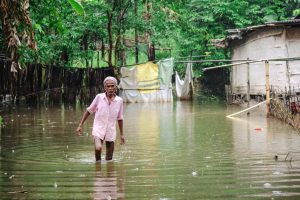India’s northeastern state of Assam is reeling from floods yet again, resulting in lost lives, damaged infrastructure, and submerged villages.
Close to 90 people have died so far and over 4 million have been affected in as many as 26 districts out of a total of 33 in the state.
The current wave of rain began in May, but a continuous downpour worsened the situation in the following weeks resulting in the overflowing of the Brahmaputra River, which flows through the state.
Flood waters have washed away bridges, damaged roads, and breached embankments at several locations across Brahmaputra Valley in the state. The central government has announced a package of 3.46 billion Indian rupees ($42 million) to handle the flood situation in the state.
The flooding in Assam was aggravated by the release of water from the Kurichu dam in Bhutan, which inundated the districts of Barpeta and Nalbari in western Assam. These twin districts, besides South Salmara and Goalpara, have been the worst affected in the entire state in terms of the number of people uprooted from their homes.
Most of the national parks and wildlife sanctuaries in Assam have also been submerged, including the two World Heritage Sites of Kaziranga and Manas as well as Dibru-Saikhowa, Orang, Nameri, Pobitora, and Laokhowa. So far 86 animals have died in Kaziranga as a result of drowning and vehicle collisions on the highway that meanders through the park.
The floods have ravaged Assam at a time when its capital and another city in the eastern region were undergoing a lockdown to prevent the further spread of the novel coronavirus. The state has logged nearly 20,000 cases so far, with 48 deaths from COVID-19. The handle the headache of providing shelter for flood victims during a pandemic, the Assam Disaster Management Authority (ASDMA) has come up with a standard operating procedure for relief camps that specifies an ideal capacity to prevent crowding.
Assam is among the most flood-prone states in India. An assessment by the Rastriya Barh Ayog (RBA) identified 3.105 million hectares in the state, or about 40 percent of Assam’s total land area, as flood prone. Assam accounts for 9.4 percent of the total land area vulnerable to flooding in India.
Many factors, both natural and artificial, cause floods in Assam: the rise in the river bed due to siltation, the unstable nature of the river, the breach of embankments, and the frequent release of water from the hydroelectric dams located in neighboring Arunachal Pradesh, Nagaland, and Bhutan.
The government’s overemphasis on repairing embankments to check floods certainly has not been successful. The Master Plans that were compiled by the government to check the menace suggested construction of dams on the tributaries of the Brahmaputra, but the existing dams have also been a frequent cause of floods in Assam.
The government had approved a project to dredge the entire Brahmaputra, spanning 891 kilometers, with the twin goals of removing silt from the river bed and increasing its water retention capacity. However, it is not precisely known when the project would actually commence – if it ever will
Likewise, a decision was taken to set up the North East Water Management Authority (NEWMA) to facilitate a coordinated approach among the states in the country’s Northeast to check the twin dangers of flood and erosion. The new agency will replace the Brahmaputra Board, which was set up in 1982 for the same purpose.
Meanwhile, the Brahmaputra Board has already begun implementing new schemes to check floods and erosion. The new strategy focuses on “soft measures” such as planting certain categories of grass on the river banks prone to erosion.
Rajeev Bhattacharyya is a senior journalist in Assam, India.

































